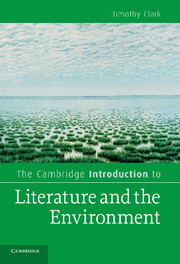Book contents
- Frontmatter
- Contents
- List of illustrations
- Preface
- Acknowledgements
- Introduction
- Romantic and anti-romantic
- The boundaries of the political
- Science and the struggle for intellectual authority
- The animal mirror
- Chapter 18 Ethics and the non-human animal
- Chapter 19 Anthropomorphism
- Chapter 20 The future of ecocriticism
- Notes
- Further reading
- Index
- Cambridge Introductions to …
Chapter 18 - Ethics and the non-human animal
Published online by Cambridge University Press: 05 June 2012
- Frontmatter
- Contents
- List of illustrations
- Preface
- Acknowledgements
- Introduction
- Romantic and anti-romantic
- The boundaries of the political
- Science and the struggle for intellectual authority
- The animal mirror
- Chapter 18 Ethics and the non-human animal
- Chapter 19 Anthropomorphism
- Chapter 20 The future of ecocriticism
- Notes
- Further reading
- Index
- Cambridge Introductions to …
Summary
In David Garnett's novella A Man in the Zoo (1924) a young man, as an extreme gesture in a row with his fiancée, has himself placed for weeks in a cage in the Ape House at London Zoo. Spectators find him on display as a species between the orang-utan and the chimpanzee. In many scenes of this novella the mere presence of the cage wires marking a strict line between the human-as-spectator and the animal-as-exhibit produces defamilarising and disturbing effects. Take the scene in which the fiancée, Josephine, arrives among the crowd of spectators:
At that moment he was engaged in walking up and down (which occupation, by the way, took up far more of his time than he ever suspected). But she could not speak to him; indeed she dreaded that he should see her.
Back and forth he walked by the wire division, with his hands behind his back and his head bent slightly, until he reached the corner, when up went his head and he turned on his heel. His face was expressionless.
The scene is both comic and disturbing. Normal conventions of signification are transgressed in a view of the human as animal and of caged animal behaviour (walking up and down) as human boredom.
- Type
- Chapter
- Information
- The Cambridge Introduction to Literature and the Environment , pp. 183 - 191Publisher: Cambridge University PressPrint publication year: 2011



